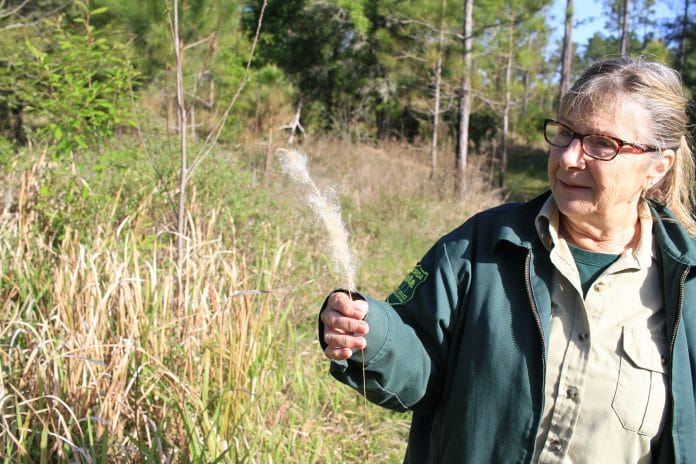ARTICLE AND PHOTOGRAPHY BY ALICE MARY HERDEN
Published May 3, 2019
Covering an expansive area, naturally, the Withlacoochee State Forest contains many invasive-exotic plants. Exotic plants are any plants brought to Florida from other regions of the United States or other countries.
One invasive-exotic is cogongrass. It has lovely green leaves and tall, fluffy white seed tails. Kathy Johnson considers it her main priority.
Kathy Johnson, 68, Park Ranger for the Florida Forest Service is one of the four women that control invasive exotics within the 160,000 acre Withlacoochee State Forest.
“I found out I had a knack for this job and kind of fell into it,” Johnson said.
Cogongrass is on the top of the list for invasive exotics growing within the Withlacoochee State Forest. It is also ranked number as the seventh worst weed in on the Federal list of noxious weeds, according to the USDA.
This plant, unfortunately, was introduced to Florida in the 1930s as a means to stabilize soil and provide forage for cattle. UF/IFAS states that the forage benefit was minimal and spread quickly, becoming a pest. With illegal planting, spread with contaminated equipment, and it’s natural ability to outcompete other species, it quickly became widespread throughout the state of Florida.
“It takes over the whole ecosystem, nothing else can grow,” Johnson said. “It grows so tight that the native plants cannot grow there and none of the animals can eat it.”
Removing invasive exotics isn’t that easy; there are specific directions the team has to follow when dealing with cogongrass as well as any other invasive exotic plant species.
The root system of cogongrass can grow to depths of four feet underground. Each patch has a deep knuckle like root system and removing that root system can take years. If they were to pull the grass up by hand, just a portion of the root would break off, leaving the underground root system intact. The plant would be able to regrow.
“What you see above ground is nothing. It’s sixty percent underground, the longer it’s there, the longer it takes to get rid of because of the root system,” Johnson explained.
Mowing gives cogongrass the opportunity for seed spreading and burning helps the grass reestablish faster.
So, how does the Florida Forest Service control the cogongrass? Herbicide spray and a team of four very dedicated women. This spray is accurately measured with specific herbicide ingredients that have been tested and proven to kill cogongrass.
Kathy Johnson along with Forest Rangers Shannon Hunt, Heather Sharkey, and Lindsey Hacker continue to remove invasive exotic plant species within the Withlacoochee Forest. Their efforts and dedication help make the forest beautiful, scenic and natural for both native plants and wildlife.

